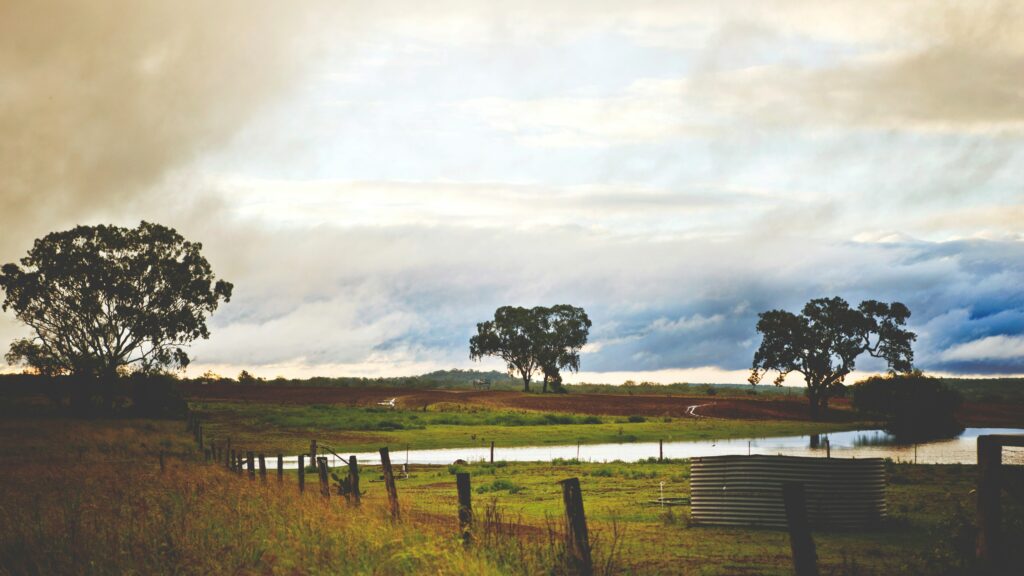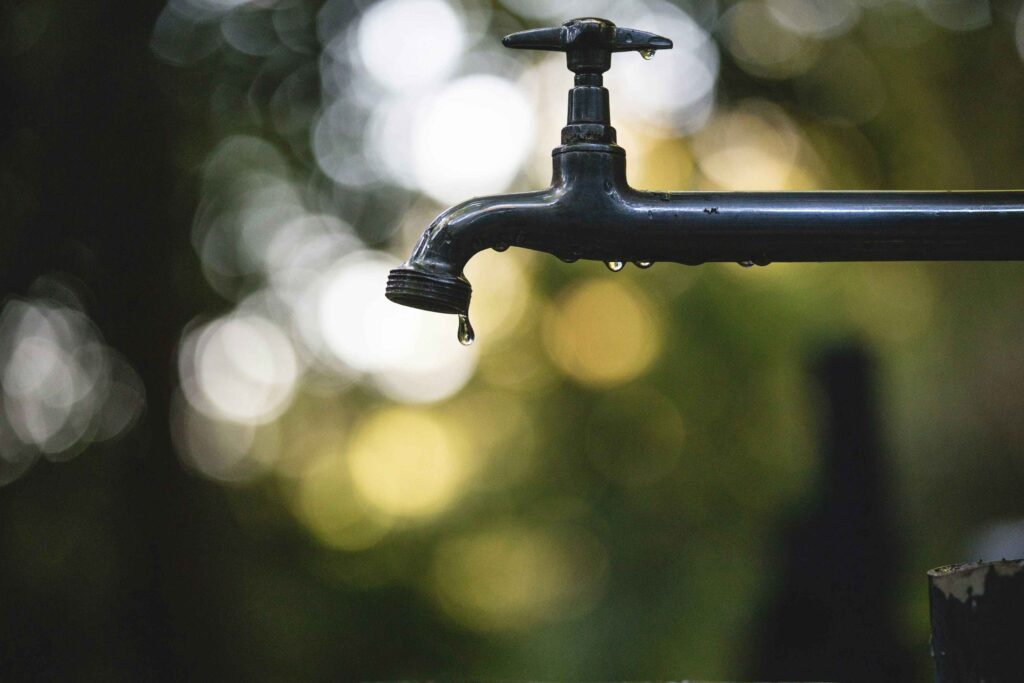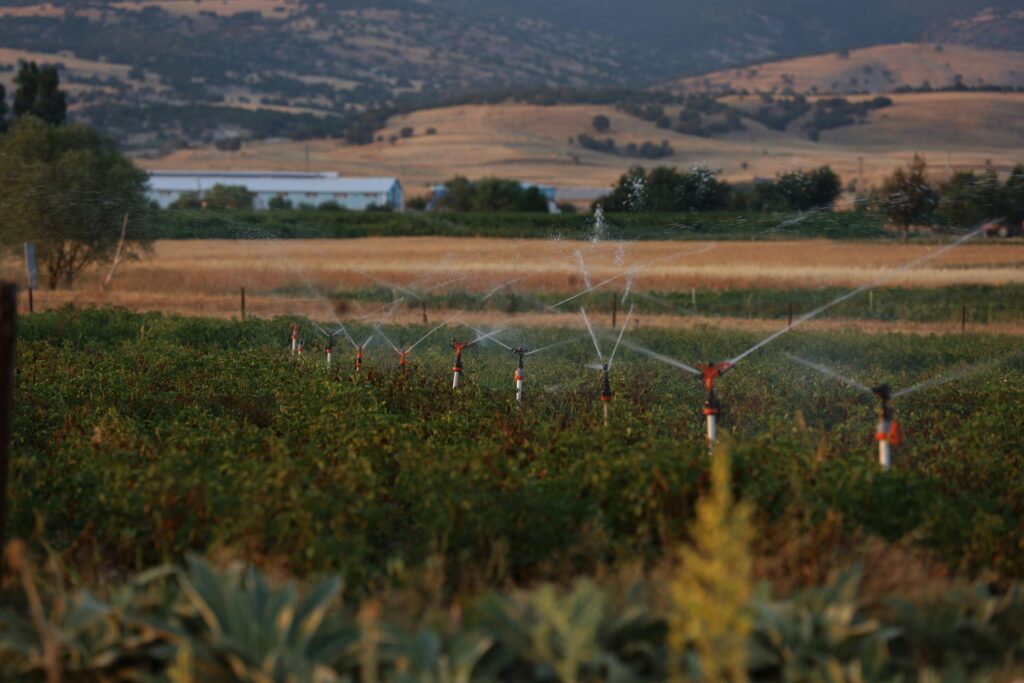Calculating water requirements accurately prevents shortages during dry periods and helps you plan adequate storage. Small farms and lifestyle blocks need water for livestock, crops, domestic use, and equipment. Understanding your total daily and seasonal demand guides infrastructure decisions and drought preparedness.
This guide shows you how to calculate water requirements for Australian small-scale farming operations.

Why Calculating Water Requirements Accurately is Important
Knowing your water needs transforms guesswork into informed planning. Accurate calculations prevent both costly over-investment and dangerous under-supply.
Matching Water Supply to Seasonal Demand
Water demand fluctuates throughout the year. Summer heat increases livestock drinking, evaporation rates, and irrigation requirements. Winter reduces irrigation needs but livestock still require daily water.
Calculating seasonal variations reveals when your property faces peak demand. This information guides storage capacity decisions. A dam adequate for winter may run dry during summer if sized on average demand rather than peak periods.
Understanding seasonal patterns helps you schedule infrastructure maintenance. Service pumps and check storage integrity before peak demand periods arrive.
Preventing Shortages and Overuse
Underestimating requirements leads to water shortages that threaten livestock welfare, crop survival, and property functionality. Shortages force expensive emergency measures like water carting or destocking.
Overestimating creates different problems. Excessive storage infrastructure wastes capital that could improve other aspects of farm productivity. Oversized dams increase evaporation losses and maintenance costs.
Accurate calculation hits the balance. Build enough capacity to handle peak demand with reasonable drought buffer, without wasting resources on unnecessary excess.
Key Factors That Affect Water Requirements
Multiple variables influence total water consumption on small farms. Understanding these factors improves calculation accuracy.
Crop Type and Irrigation System
Different crops demand vastly different water volumes. Pasture irrigation varies from 2-6 megalitres per hectare annually depending on climate and pasture type. Vegetable gardens require 4-8 megalitres per hectare. Fruit trees need 3-6 megalitres per hectare.
Irrigation system efficiency dramatically affects actual water requirements. Drip irrigation delivers water directly to root zones with minimal waste. Spray systems lose 20-40% to evaporation and wind drift. Flood irrigation wastes even more through runoff and deep percolation.
Climate zone matters enormously. Northern Queensland properties face higher evapotranspiration than cool-climate Tasmania. Account for local rainfall and temperature when calculating irrigation needs.
Livestock Numbers and Species
Cattle require 55-112 litres per head daily depending on size, lactation status, and temperature. Sheep need 4-6 litres per day, more if lactating. Horses consume 30-50 litres daily. Goats require 4-10 litres per head.
Lactating animals require substantially more water than dry stock. Lactation demands at least 50% more water than maintenance. Plan for peak lactation periods in your calculations.
Temperature affects consumption significantly. Hot weather increases drinking by 50-100%. Factor in summer peaks rather than average conditions.
Soil Type and Evaporation
Sandy soils drain quickly, requiring more frequent irrigation. Clay soils hold moisture longer but drain poorly. Loam provides ideal water-holding capacity.
Soil type affects irrigation scheduling and total volume requirements. Sandy soils need smaller, more frequent applications. Clay soils benefit from less frequent, deeper watering.
Evaporation removes water before plants or animals can use it. Open water bodies lose 5-10mm daily during summer in hot regions. Calculate evaporation losses when planning dam or tank storage.
Domestic and Garden Water Use
Household consumption adds to farm water requirements. Average Australian households use 200-300 litres daily per person. Rural properties often use more due to outdoor cleaning, equipment washing, and dust management.
Gardens, lawns, and landscape plantings consume additional water. Home vegetable gardens might use 500-2,000 litres weekly depending on size and irrigation method.
Equipment washing, stock handling facilities, and dairy cleaning operations require separate water allocation. These uses are often overlooked but can consume significant volumes.
How to Calculate Water Requirement Step-by-Step
Follow this systematic approach to determine your property’s water needs.
Step 1: Determine Average Rainfall and Catchment Area
Access rainfall data from the Bureau of Meteorology for your specific location. Note average annual rainfall and monthly distribution. Identify your region’s dry season length.
Calculate your catchment area – the surface area that captures rainfall. Roof catchment equals roof area in square metres. Dam catchment includes all land that naturally drains into your dam during rain events.
A simple formula estimates rainwater capture:
Catchment area (m²) × Rainfall (mm) × 0.8 = Litres captured
The 0.8 factor accounts for losses through evaporation, absorption, and inefficient capture. More precise calculations use specific runoff coefficients for different surfaces.
For example: A 200m² roof receiving 600mm annual rainfall captures approximately: 200 × 600 × 0.8 = 96,000 litres annually
Step 2: Calculate Daily Water Requirement by Enterprise
Break down water needs by category. The figures below are general estimates for planning purposes – actual consumption varies by temperature, animal size, lactation status, and local conditions.
Livestock water requirements (typical daily consumption):
| Livestock Type | Daily Water Requirement | Notes |
| Cattle | 55-112 litres per head | Use 80L for planning; increases with heat and lactation |
| Sheep | 4-6 litres per head | Higher in summer and for lactating ewes |
| Horses | 30-50 litres per head | Use 40L for planning |
| Goats | 4-10 litres per head | Use 8L for planning |
| Poultry | 0.3-0.5 litres per bird | Varies by size and temperature |
Irrigation requirements:
Water requirements are expressed in millimetres or megalitres per hectare. One megalitre equals 100mm applied over one hectare. These figures are indicative only and vary significantly by climate zone, season, and specific crop varieties.
| Crop/Use | Annual Requirement | Notes |
| Improved pasture | 2-6 ML/ha (200-600mm) | Higher in hot, dry climates |
| Vegetable gardens | 4-8 ML/ha (400-800mm) | Intensive production requires upper range |
| Fruit trees | 3-6 ML/ha (300-600mm) | Depends on tree density and variety |
Convert annual figures to daily requirements during irrigation season. For example, 4 ML/ha over a 180-day irrigation season equals approximately 22,000 litres per hectare daily.
Domestic water:
- Household use: 250 litres per person daily
- Garden watering: 100-300 litres daily depending on size
- Equipment washing: 50-200 litres per occasion
Step 3: Multiply to Estimate Total Seasonal Use
Calculate total water requirements across all enterprises:
(Number of livestock × Daily requirement per head) + (Irrigated area × Daily requirement per hectare) + Domestic daily use = Total daily requirement
Multiply daily requirements by season length to estimate total seasonal consumption.
Summer typically demands the highest daily volumes. Calculate a separate summer total to identify peak demand periods.
Step 4: Adjust for System Losses and Drought Buffer
Real-world water use always exceeds calculated requirements due to losses. The percentages below are estimates based on typical systems – actual losses vary by infrastructure condition and management practices.
| Loss Source | Typical Loss Range |
| Pipeline leaks | 5-15% |
| Trough overflow and spillage | 5-10% |
| Evaporation from storage | 10-30% (varies by surface area and climate) |
| Inefficient irrigation application | 20-40% for overhead systems |
| Total adjustment recommended | Add 30-50% to calculated requirements |
Include a drought buffer; additional storage to sustain your operation during extended dry periods. Calculate how long your property can operate without rainfall, then size storage accordingly.
A three-month buffer suits most situations. Six months provides greater security in drought-prone regions.
Example: Calculating Water Requirement Per Day for 20 Cattle and 5 Hectares of Pasture
Consider a small farm in regional NSW with:
- 20 beef cattle
- 5 hectares of irrigated improved pasture
- 2 people in household
- 150-day summer irrigation season
| Category | Calculation | Daily Requirement |
| Livestock water | 20 cattle × 80 litres | 1,600 litres |
| Irrigation water | 5 ha requiring 4 ML annually<br>= 20 ML total<br>÷ 150 days | 133,333 litres |
| Domestic water | 2 people × 250 litres | 500 litres |
| Garden watering | Estimate for modest garden | 200 litres |
| Subtotal (daily summer requirement) | 135,633 litres | |
| Adjust for 40% losses | 135,633 × 1.4 | 189,886 litres (~190,000L) |
Seasonal and drought buffer calculations:
| Requirement Type | Calculation | Total Volume |
| Summer season requirement | 190,000 litres × 150 days | 28.5 megalitres |
| Drought buffer (3 months) | 190,000 litres × 90 days | 17.1 megalitres |
| Total storage needed | 45.6 megalitres minimum |
This property needs substantial water storage to operate through summer plus a drought buffer. Without adequate storage, water shortages become inevitable.
Note: This example uses mid-range estimates. Actual requirements vary based on cattle size, pasture species, soil type, temperature, and numerous other factors. Calculate using your specific circumstances and monitor actual usage to refine estimates.
How to Calculate Water Requirement Per Day
Daily calculations help with operational planning and usage monitoring.
Livestock Drinking Needs
Use conservative high estimates when calculating livestock water requirements. Hot weather, lactation, and feed type all increase consumption above average figures.
Monitor actual consumption by observing tank or trough levels. This reveals whether your estimates align with reality. Adjust calculations based on observed use.
Provide 20% excess capacity in troughs and tanks. This ensures all animals can drink even during peak demand times.
Irrigation Timing and Duration
Daily irrigation requirements depend on crop type, growth stage, and weather conditions.
Peak demand occurs during rapid growth periods and extreme heat. Young crops with developing root systems need frequent light watering. Established crops benefit from deeper, less frequent irrigation.
Soil moisture monitoring guides irrigation timing. Water when soil reaches a predetermined moisture threshold rather than on fixed schedules. This prevents over-watering and under-watering.
Calculate run times based on irrigation system output. Measure how many millimetres your system applies per hour, then calculate duration needed to apply target volumes.
Household and Equipment Use
Track household water use over several billing periods. This reveals actual consumption patterns rather than estimates.
Equipment washing varies by operation. Cattle yards might need hosing weekly. Dairy operations require daily cleaning consuming 100-500 litres.
Budget for unexpected uses. Equipment repairs, construction projects, and maintenance activities create temporary spikes in water demand.
Water Storage and Supply Options
Different storage and supply systems suit different properties and requirements.
Tanks, Dams, and Bores
Rainwater tanks capture roof runoff for household and livestock use. Size tanks based on roof area, rainfall patterns, and intended use. Minimum 20,000 litres suits basic household needs. Larger operations need multiple tanks totalling 100,000+ litres.
Dams provide bulk storage for irrigation and extensive livestock operations. Calculate required dam capacity based on total seasonal requirements plus evaporation losses. Site dams to maximise catchment while minimising evaporation surface area.
Bore water offers reliable supply independent of rainfall. Bore yield and water quality determine suitability. Test water quality before relying on bores for drinking water. Some bore water suits irrigation but not livestock consumption.
Pumped vs Gravity-Fed Systems
Gravity-fed systems require no ongoing energy input. Position storage uphill from use points. Every 10 metres of elevation provides approximately 100 kPa pressure – adequate for most applications.
Pumped systems offer flexibility but consume energy. Solar pumps suit remote installations. Mains-powered pumps suit properties with reliable electricity but add ongoing operational costs.
Calculate pump capacity based on peak simultaneous demand. Pumps must deliver sufficient flow when irrigation operates while livestock drink and household taps run.
Reuse and Rainwater Capture
Greywater reuse reduces total water requirements. Treated household greywater irrigates gardens and non-food plants. Check local regulations – some areas restrict greywater use.
Capture runoff from hard surfaces like driveways, yards, and barn roofs. Redirect this water to storage or irrigation rather than allowing it to leave your property.
Swales and contour banks slow water movement across paddocks, increasing infiltration. This reduces irrigation requirements by improving soil moisture.
Improving Water Efficiency
Strategic efficiency improvements reduce total water requirements without compromising productivity.
Scheduling Irrigation
Irrigate during cooler parts of the day. Early morning or late evening application minimises evaporation losses.
Match irrigation timing to plant needs. Water as soil moisture depletes rather than on fixed schedules. Use soil moisture sensors or simple manual monitoring.
Split large irrigation applications into multiple smaller events. This improves infiltration and reduces runoff, ensuring more water reaches plant roots.
Soil Moisture Management
Improve soil water-holding capacity through organic matter additions. Compost, mulch, and cover crops increase soil’s ability to capture and retain moisture.
Mulch reduces evaporation from soil surfaces by 30-70%. Apply 50-100mm of organic mulch around crops and trees.
Reduce cultivation that destroys soil structure. No-till or minimal tillage preserves soil moisture more effectively than frequent ploughing.
Leak Detection and Monitoring Tools
Check pipes, fittings, and troughs weekly for leaks. Small leaks waste thousands of litres over time. Fix leaks immediately rather than deferring repairs.
Install water meters at key points to track consumption. This reveals where water goes and identifies unusual usage indicating leaks or problems.
Smart monitoring systems alert you to abnormal consumption patterns. These systems catch problems before they waste significant water.
Planning Water Requirements for Dry Seasons
Proactive drought planning prevents crisis management during water shortages.
Tracking Water Usage Trends
Record water usage monthly across multiple years. This reveals seasonal patterns and long-term trends in consumption.
Compare actual usage against calculated requirements. Large discrepancies indicate either calculation errors or system inefficiencies requiring investigation.
Identify your property’s most vulnerable period; typically late summer before autumn rains arrive. Plan storage to cover this critical period plus safety margin.
Increasing Water Storage Capacity
Add storage before shortages develop. Emergency storage expansion during drought proves expensive and difficult.
Evaluate whether existing storage handles peak demand plus drought buffer. Undersized storage guarantees problems during dry years.
Consider multiple smaller storages rather than one large dam. This provides redundancy and reduces total evaporation surface area.
Temporary Water Supply Options
Identify water carting services before emergencies arise. Know local suppliers, delivery costs, and availability during widespread drought.
Plan for temporary storage if carting becomes necessary. Bladder tanks or additional temporary tanks accommodate delivered water.
Reduce discretionary use during shortages. Prioritise livestock drinking water and essential household needs. Accept crop and garden losses rather than exhausting all reserves.
Conclusion
Accurate water requirement calculations underpin sustainable small farm management. Understanding daily and seasonal needs guides infrastructure investment, prevents shortages, and improves resource efficiency.
Calculate requirements systematically: assess rainfall and catchment, determine needs by enterprise, multiply for seasonal totals, and add appropriate buffers for losses and drought. Monitor actual usage against calculations to refine estimates over time.
Water security determines which farming enterprises are viable on your property. Calculate before you invest in livestock or irrigation systems. Plan storage capacity to meet peak demand during dry periods, not just average conditions.
Note: All water requirement figures in this guide are estimates based on typical conditions. Actual requirements vary by climate, management practices, animal genetics, and numerous other factors. Monitor your specific property’s water use and adjust calculations accordingly.


